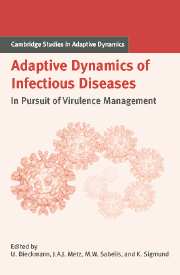Book contents
- Frontmatter
- Contents
- Contributing Authors
- List of Boxes
- Notational Standards
- 1 Introduction
- A Setting the Stage
- B Host Population Structure
- C Within-Host Interactions
- Introduction to Part C
- 9 Super- and Coinfection: The Two Extremes
- 10 Super- and Coinfection: Filling the Range
- 11 Multiple Infection and Its Consequences for Virulence Management
- 12 Kin-selection Models as Evolutionary Explanations of Malaria
- D Pathogen–Host Coevolution
- E Multilevel Selection
- F Vaccines and Drugs
- G Perspectives for Virulence Management
- References
- Index
- International Institute for Applied Systems Analysis
12 - Kin-selection Models as Evolutionary Explanations of Malaria
Published online by Cambridge University Press: 15 January 2010
- Frontmatter
- Contents
- Contributing Authors
- List of Boxes
- Notational Standards
- 1 Introduction
- A Setting the Stage
- B Host Population Structure
- C Within-Host Interactions
- Introduction to Part C
- 9 Super- and Coinfection: The Two Extremes
- 10 Super- and Coinfection: Filling the Range
- 11 Multiple Infection and Its Consequences for Virulence Management
- 12 Kin-selection Models as Evolutionary Explanations of Malaria
- D Pathogen–Host Coevolution
- E Multilevel Selection
- F Vaccines and Drugs
- G Perspectives for Virulence Management
- References
- Index
- International Institute for Applied Systems Analysis
Summary
Introduction
Malaria, a disease caused by protozoan parasites of the genus Plasmodium, can substantially reduce host fitness in wild animals (Atkinson and Van Riper 1991; Schall 1996). In humans, the major disease syndromes – severe anemia, coma, and organ failure, as well as general pathology such as respiratory distress, aches, and nausea – cause considerable mortality and morbidity (Marsh and Snow 1997).
Biomedical research attributes malaria to red cell destruction, infected cell sequestration in vital organs, and the parasite-induced release of cytokines (Marsh and Snow 1997). But mechanistic explanations are just one type of explanation for any biological phenomenon, and, in recent years, evolutionary biologists have become interested in offering evolutionary explanations of infectious disease virulence. This is entirely appropriate (Read 1994). In the context of malaria, for example, the clinical outcome of infection has an important impact on parasite and host fitness and is – at least in part – determined by heritable variation in host and parasite factors (Greenwood et al. 1991). Yet in the recent rush to provide evolutionary explanations of disease, there has been, in our view, too little interaction between the models built by evolutionary biologists and reality. There is unlikely to be a simple, general model of virulence: the causes of disease and the fitness consequences for host and parasite are too variable. Instead, different models, and even different frameworks, will be relevant in different contexts.
Information
- Type
- Chapter
- Information
- Adaptive Dynamics of Infectious DiseasesIn Pursuit of Virulence Management, pp. 165 - 178Publisher: Cambridge University PressPrint publication year: 2002
Accessibility standard: Unknown
Why this information is here
This section outlines the accessibility features of this content - including support for screen readers, full keyboard navigation and high-contrast display options. This may not be relevant for you.Accessibility Information
- 14
- Cited by
